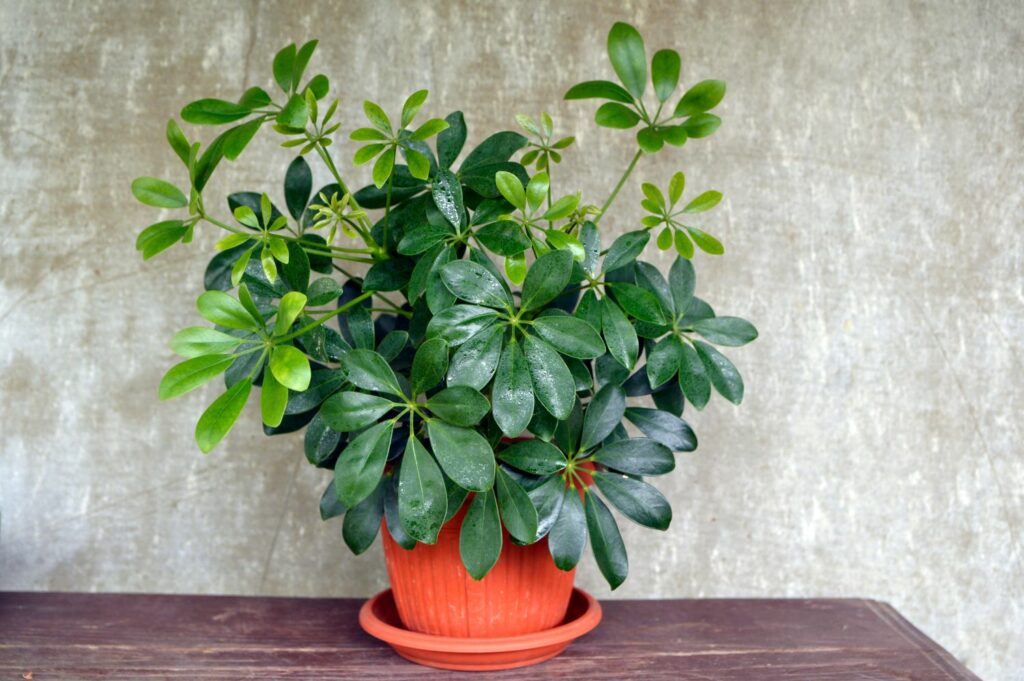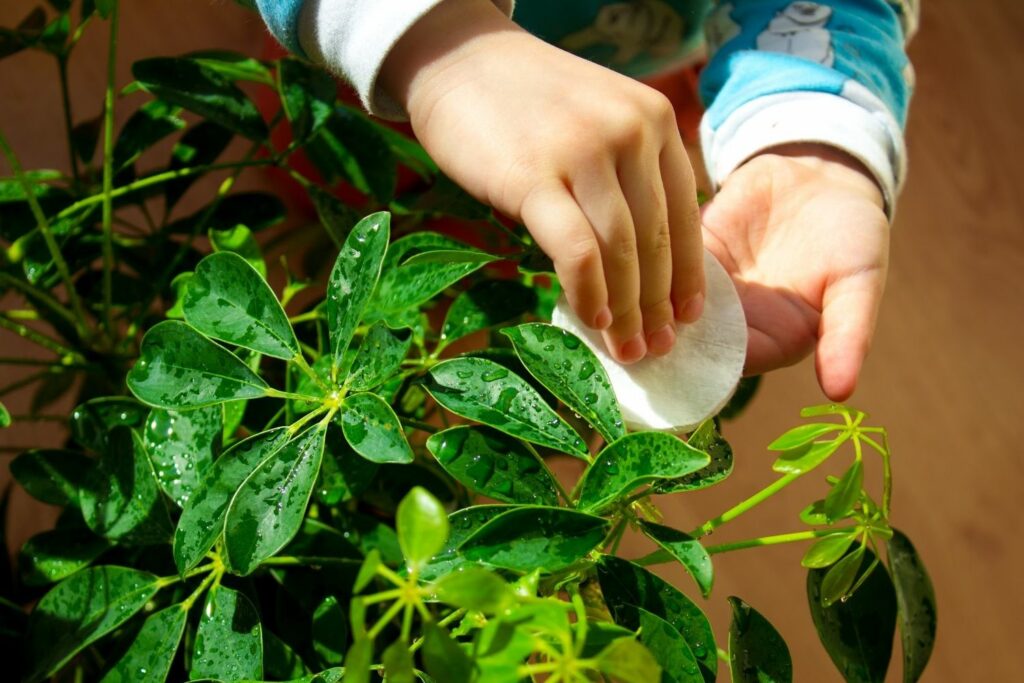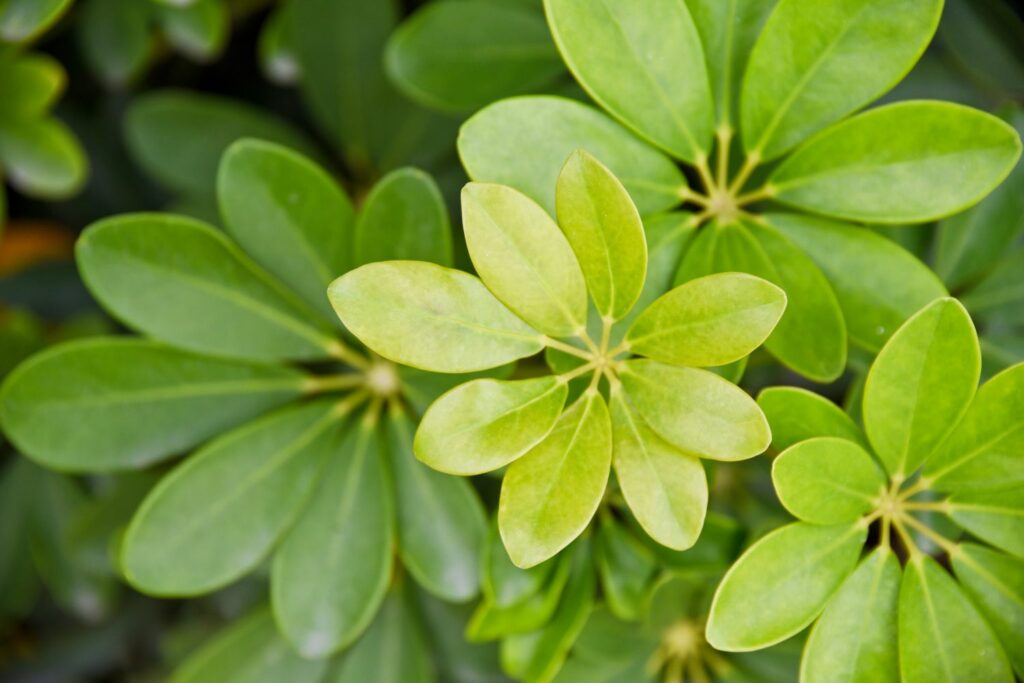Umbrella plants, also known as schefflera are popular houseplants known for their glossy evergreen foliage. However, it can be alarming when your umbrella plant suddenly starts dropping leaves.
There are several potential causes for an umbrella plant dropping its leaves, but the problem can usually be corrected with a few simple adjustments to the plant’s care. Here are the most common reasons an umbrella plant may lose its leaves and what you can do about it.
Overwatering
One of the most frequent reasons for dropped leaves on an umbrella plant is overwatering Umbrella plants prefer moist but not soggy soil. If the soil stays too wet for too long, it can lead to root rot This disease damages the plant’s root system and prevents the roots from taking up water and nutrients properly. As a result, the leaves will start to yellow, wilt and eventually drop off.
To fix overwatering, allow the soil to dry out completely between waterings. Then, water thoroughly only when the top inch or two of soil becomes dry to the touch. Be sure the pot has drainage holes to prevent waterlogged soil. It may also help to repot the plant in fresh, well-draining soil.
Underwatering
While overwatering is common, an umbrella plant can also drop leaves if it receives too little water. Umbrella plants should be watered whenever the top few inches of soil become dry. If you forget to water and the soil dries out completely, the leaves may start to fall off as the plant becomes stressed.
To prevent underwatering, check the soil moisture frequently and water when needed. Water until it drains freely from the drainage holes. The plant may also benefit from repotting in a soil mix that retains moisture better.
Improper Lighting
Umbrella plants need bright, filtered light to thrive. Too little light will cause the leaves to fall off over time. But direct hot sunlight can scorch the leaves and cause leaf loss as well.
Place the umbrella plant near a sunny window filtered by a sheer curtain. Rotate the plant periodically so all sides receive adequate light. If the lighting is too low, consider a supplemental grow light.
Temperature Stress
As tropical plants, umbrella plants prefer consistent warm temperatures between 65-80°F. Exposure to colder or hotter temperatures can put stress on the plant and cause dropped leaves.
Keep the plant away from drafty windows in winter. In summer, keep it out of hot sun and avoid rooms over 80°F. Maintain ideal growing temperatures year-round.
Low Humidity
The tropical origins of the umbrella plant mean it prefers 40-50% relative humidity. In the dry air of homes, leaves can dry out and drop off.
Increase humidity around the umbrella plant by misting the leaves daily or using a pebble tray. Keep the plant away from heating/cooling vents which can dry the air.
Drafts
Sudden changes in temperature and exposure to drafts will shock the umbrella plant, potentially causing leaf loss.
Site the plant away from frequently opened doors and windows. Close vents blowing directly on the plant. Use screens or curtains to shelter the plant from drafts.
Pests
Spider mites, mealybugs, thrips and other pests can infest umbrella plants and cause leaf loss. Check closely for any signs of bugs on the plant.
Treat infestations immediately with insecticidal soap spray or neem oil. Remove any heavily infested leaves and isolate the plant to prevent spreading.
Nutrient Deficiencies
An umbrella plant dropping leaves may indicate it needs more fertilizer. These plants are heavy feeders and require regular nutrients.
Fertilize the plant every 2-4 weeks in the growing season with a balanced liquid fertilizer diluted by half. Test the soil and adjust as needed.
Repotting Stress
Repotting or dividing an umbrella plant can disturb the roots and cause some leaf drop afterward as the plant recovers.
Avoid repotting right before the dormant season. Water sparingly after repotting until the plant adjusts. Gradually return to a normal watering schedule.
Natural Leaf Drop
Umbrella plants will naturally shed some older leaves as new growth emerges. As long as it is not excessive, this is usually nothing to worry about.
Remove any dropped leaves promptly. Monitor the plant for other signs of stress like wilting. As long as new growth is healthy, natural leaf drop is normal.
How to Prevent Umbrella Plant Leaf Drop
With proper care, an umbrella plant should grow lush and full without excessive leaf drop. Here are some tips to keep your umbrella plant healthy and minimize leaf loss:
- Water thoroughly only when the top inch of soil is dry
- Provide bright, indirect light near a window
- Maintain indoor temperatures between 65-80°F
- Increase humidity through misting and pebble trays
- Shelter from drafts and direct sun
- Fertilize regularly in the growing season
- Inspect frequently for pests
- Repot every 2-3 years in fresh soil
- Allow time to adjust after repotting
By following these simple care guidelines, your umbrella plant should thrive indoors with minimal leaf drop. Check the plant regularly for any signs of stress and address them promptly. With proper care, umbrella plants can grow for many years as attractive and easy-to-care-for houseplants.

You want to know who’s behind Plantura?


I study landscape ecology and through my studies have discovered a love for plants. Plants are not only beautiful, but also have countless fascinating survival strategies. To bring a bit of nature into my home as well, I nurture my houseplants and herbs on every possible windowsill. Favourite fruit: rhubarb and all kinds of berries Favourite vegetables: onions and garlic
Caring for an umbrella plant is not difficult and, given a little TLC, this plant will grow well and produce lots of glossy leaves. Learn all about your Schefflera’s needs and concerns.

Water and nutrients are the umbrella plant’s (Schefflera arboricola) two most basic needs. The occasional pruning also benefits the plant and promotes bushy growth. Read on to learn more about umbrella plant care, including tips on recognising when it is time to repot your Schefflera.
This article focuses on the dwarf umbrella tree, also known as umbrella plant and dwarf schefflera. For other Schefflera species, such as the more demanding false aralia (Schefflera elegantissima), visit our overview article on Schefflera.
In order for your Schefflera to grow strong, the right care and environment are important. Regular watering and fertilising are key to keeping your plant happy and healthy.
Umbrella plants tolerate the occasional dryness better than too much moisture. Allow the soil to dry between waterings, and check if it is dry to the touch before watering again. Hard water can lead to calcium build up on a Schefflera’s leaves, hindering its ability to absorb nutrients. So, opt for soft water or rainwater if possible. Watering umbrella plants by the immersion method has been proven to be effective. To do this, briefly immerse the plant’s pot in a bucket of water until no more air bubbles rise up. Be sure to let the soil drain well before returning the umbrella plant back to its place.

Tip: To help your Schefflera retain its beautiful lustre, mist it with calcium-free water, and wipe the dust off the leaves from time to time.
Apart from during their dormant period in winter, umbrella plants need nutrients every two weeks for healthy growth. A liquid plant fertiliser, such as our Plantura Liquid Houseplant Food, works wonders and is easy to apply. Our organic fertiliser helps Schefflera plants to grow magnificent leaves and also supports the roots, ensuring that the plant stays strong and healthy. To apply, simply dilute some of the liquid fertiliser into water and water as usual. This ensures that the nutrients are evenly distributed in the soil and quickly available to the plant.

- Perfect for a wide variety of houseplants & foliage plants
- Liquid fertiliser for robust plants & healthy growth
- Quick & easy application – child & pet friendly
Pruning umbrella plants
If your Schefflera gets too big, it can be cut back without a problem. The best time of year to prune umbrella plants is in spring, but it is also possible to prune later in the year. That said, we explicitly advise against pruning umbrella plants during the winter months. When pruning, remove crooked, leafless or troublesome shoots. Always cut just above a node or branch fork. If the cutting is healthy, you can go ahead and use it to propagate your Schefflera.
Schefflera branching: To encourage bushier growth, shorten the shoot ends to the desired height. Your umbrella plant will sprout more shoots from where the cut was made, which will give your plant a fuller look.

4 Reasons the Dwarf Umbrella Plant is Dropping Leaves?
FAQ
Why are leaves falling off of my umbrella plant?
Waterlogging: waterlogging can cause root rot in Schefflera plants. Root rot causes the plant to shed the leaves that are no longer getting water or nutrients.
What does an overwatered umbrella plant look like?
If you notice that the plant has yellowing leaves or is dropping leaves, you may be overwatering. Water once the compost is dry on the top – around a third of the compost should be dry. Stick your finger in to check it’s dry beneath the surface.
How often should I water my umbrella plant?
-
General Watering:
- Let the top inch dry: Don’t keep the soil constantly soggy, but also don’t let it dry out completely.
- Water thoroughly: When you do water, make sure the soil is well-soaked, allowing excess water to drain out of the drainage holes.
- Let the top inch dry: Don’t keep the soil constantly soggy, but also don’t let it dry out completely.
-
Seasonal Adjustments:
- Spring/Summer (Active Growth): Water more frequently as the plant is actively growing.
- Fall/Winter (Dormant): Reduce watering frequency as the plant’s growth slows down.
- Spring/Summer (Active Growth): Water more frequently as the plant is actively growing.
-
Signs of Overwatering:
- Yellowing or dropping leaves can indicate overwatering.
- Fungal or root rot can also be a sign of overwatering.
- Yellowing or dropping leaves can indicate overwatering.
-
Light and Humidity:
- Umbrella plants prefer bright, indirect light and can tolerate lower light conditions, but may not thrive in very low light.
- They also benefit from higher humidity levels, so consider misting the leaves or placing the plant on a pebble tray with water.
- Umbrella plants prefer bright, indirect light and can tolerate lower light conditions, but may not thrive in very low light.
-
Other Care Tips:
- Drainage: Ensure your pot has good drainage to prevent waterlogging.
- Soil: Use well-draining potting mix.
- Pruning: You can prune your umbrella plant to maintain its shape or remove dead or damaged leaves.
- Drainage: Ensure your pot has good drainage to prevent waterlogging.
How to fix a droopy umbrella plant?
Drooping leaves are often a sign of underwatering. Check the soil’s moisture level and ensure you’re watering your plant adequately. Also, ensure it’s not exposed to drafts or extremely low humidity.
Why does my umbrella plant drop leaves?
Fungal issues and leaf blight can cause leaf problems: misting may actually promote the environment they thrive in. Prune infected leaves for safe disposal. An umbrella plant with dropping leaves may be entirely healthy, as old foliage naturally drops off as the plant grows.
Why do umbrella plants turn yellow?
Most often, the reason I see an umbrella plant’s leaves turning yellow is because the temperature is too low. If the temperature drops suddenly, then the leaves typically drop off, but if the leaves are turning yellow, then it is likely the plant is slightly too cold, often at night.
Why is my umbrella plant drooping?
When you underwater your umbrella plant, the roots suffer from dehydration due to insufficient moisture in the soil. As a result, the roots fail to carry water and nutrients to the plants, becoming weak and losing their leaves. Dry soil, curly leaves, droopy, crispy, and yellow leaves are some signs of underwatering.
Do umbrella plants lose leaves?
Avoid leaf loss and keep your umbrella plant’s foliage full by catering care to match its preferences for bright, humid conditions. If your umbrella plant continues losing leaves despite your best efforts, reassess the care regimen and environment.
Do umbrella plants drop leaves after repotting?
Leaf drop after repotting or moving the plant is temporary. Prune away any dead or dying leaves and branches to improve the plant’s appearance and ability to photosynthesize. As conditions improve and you eliminate stressors, the umbrella plant will stop dropping leaves and produce new, healthy foliage.
Why do umbrella plants die?
Fungal infection which is caused by overly damp soil due to overwatering and poor drainage. The sticky substance on the leaves is honey due cause by an insect infestation. Umbrella plants usually die because they are living in conditions that are significantly contrary to their natural environment.
